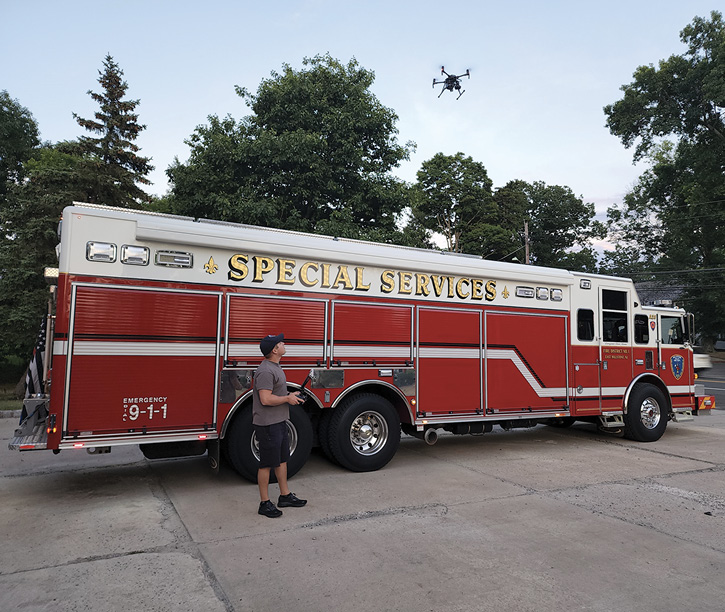
Drones are becoming more consistent in their ability to hover, are better able to carry heavier payloads, and are using greatly improved camera and infrared (IR) technologies. These and other recent developments in unmanned aerial vehicles (UAVs) have increased their use in fire service applications.
Chris Carnahan, South Metro (CO) Fire Rescue emergency communications manager, says South Metro has used its UAVs for a number of types of emergency situations, from structure fires and motor vehicle accident scenes to wildland fires, hazardous materials responses, and search and rescue operations both on land and over the water. Carnahan says South Metro’s primary drones are the DJI Mavic Enterprise Pro outfitted with a state-of-the-art FLIR (forward looking infrared) camera, four DJI Mavic Enterprise Dual drones carrying both visible light and infrared (IR) cameras, and a DJI Matrice 300 UAV.
- See Colorado Springs (CO) Fire Department’s New Drone in Action
- Darley Launches New Unmanned Systems, Metaverse & Robotics Division Aimed at Three Main Markets
- Phoenix (AZ) Fire Department Launches Drone Program
- Drones in the Fire Service: ‘Use Will Continue to Grow’
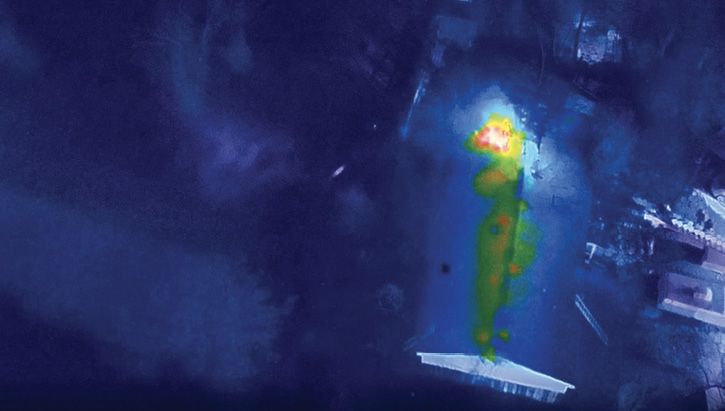
1 South Metro (CO) Fire Rescue used a DJI Mavic Enterprise Dual drone to identify hot spots in the attic of this structure fire during a rainstorm. (Photos 1-2 courtesy of South Metro Fire Rescue.)
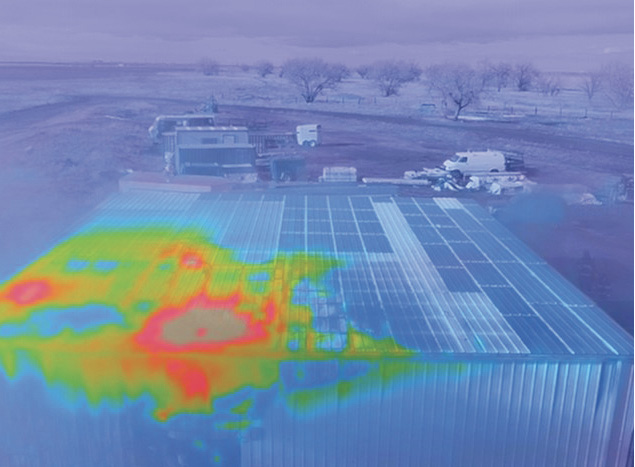
2 South Metro’s UAV clearly showed the hot spots in this building during a hazardous material call.
“The Mavics are the drones that are the quickest to get up in the air,” Carnahan observes. “We are getting them up in three to four minutes after parking the truck.” South Metro carries its drones on three Chevy SUVs and one Dodge Ram 5500 truck with a rescue box.
“We are using the drones for initial attack reconnaissance,” he points out. “We had a recent attic fire during a storm that was still active but were able to get our drone up to survey the scene and detect hot spots instead of putting firefighters on the roof. They also are useful in helping scene commanders make smart decisions based on what they see with the drone, like maybe cutting an inspection hole instead of a full roof vent hole in order to keep firefighters safe.”
Carnahan notes South Metro has used its drones on a lot of water rescues and dive calls as well as for wildland fire surveillance. “We like to have eyes in the air,” he says. “We flew our drones over a third-alarm wildland fire the 4th of July weekend where we put up a couple of drones to allow the incident commander to see where the fire was going and to allocate resources to protect structures. We flew 25 missions over that three-day weekend.”
South Metro also is flying its UAVs on nonemergency missions, Carnahan says, with the fire marshal’s office using them for fire investigation and a Geographical Information Systems team using the drones for mapping functions of buildings and water and gas lines. “We also are flying wildland fire mitigation missions where we are looking at identifying large wildland target hazards,” he adds.
Bruce Ireland, Unmanned Aircraft (or Aerial) System (UAS) salesman for W.S. Darley & Company, points out DJI UAVs are the most popular drones Darley provides to fire departments, followed by those made by Autel Robotics and PARROT. “The DJI Mavic 2 Enterprise Advanced was the most popular with the fire service because of its compact size and great optical and IR capabilities,” Ireland says. “Then DJI came out with the Matrice 30 series with the capabilities of the optical camera and IR on the larger Matrice 300 drone. The M30 is a smaller all-weather UAV that is housed in a Pelican case and can be ready in a minute, with nearly the same capabilities as the bigger M300.”
Jeb Brown, Darley’s director of robotics, adds that Darley also offers the Autel Robotics EVO II Enterprise series UAV that has three payload options of optical camera and two versions of optical and IR cameras, the EVO Light and EVO Nano series drones. Darley also offers the PARROT ANAFI USA GOV drone that is able to be flown beyond line of sight.
Peter Darley, Darley’s executive vice president and chief operating officer, points out that Ford Motors recently sent Darley two Ford Bronco SUVs for development as drone platforms. “They want us to develop two versions: a wildland version and a fire/police version, where a quadcopter drone can be launched from the vehicles.”
Sean Phetchanpheng, head of training and R&D for Darley, says Darley’s plan is to use a DJI Matrice 30 drone remotely carried in a box mounted on top of the Bronco so it can be rapidly deployed. “It would be flight ready because the box would have infrastructure to keep the aircraft charged and ready to go,” he says, “and when it lands back in the box, it will get recharged.” Phetchanpheng says Darley also is working on a mobile command box about the size of a suitcase that will have a 15-inch display screen, an internal battery to power it and for emergency recharging, and storage.”
Phetchanpheng adds Darley is also working with new technology of smaller, high-intensity LED lighting to be carried on the larger DJI Matrice 300 aircraft. “A typical spotlight is the Wingsland Z15 that puts out 10,000 to 15,000 lumens and will work either tethered or untethered,” he says. “There’s also a Blue Vigiltether for the M300, and we are working on putting 100,000 lumens of LED light on it.”
Clint Fey, division chief of special operations for West Metro (CO) Fire Rescue, carries a DJI Matrice M300 with an IR camera and an XT2 sensor optical camera with 200x zoom in his Ford F-150 response vehicle. Fey says that West Metro also has purchased a DJI Mavic 2 Enterprise Advanced UAV with an optical and IR camera. “As part of our 98-person minimum staffing, we have three on-duty fire investigators who will carry the Mavic 2 Enterprise. We are in the process of training them to get their Federal Aviation Administration Part 107 license, and when that happens, we will have 24/7/365 response with a drone.”
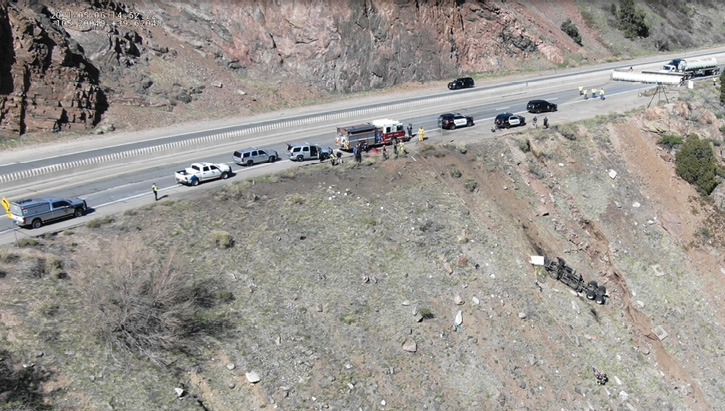
3 West Metro (CO) Fire Rescue used a DJI Matrice 300 RTK to identify the hazardous materials potential of this semi-tractor trailer that went off a roadway and over a cliff. (Photos 3-4 courtesy of West Metro Fire Rescue.)

4 The West Metro incident commander on the scene of this structure fire received real-time situational awareness data from one of the department’s UAVs flying overhead.
Fey says West Metro has used the drones on structure fires, wildland fires, technical rescues, lost persons, and backcountry rescues. “We’ve used the drones on wildland fires where they were sending near real-time imaging on the fire and the path the crews were using to hike in to fight it,” Fey notes. “Those drone images enhance safety and make the call a lot more efficient. We also had a hazmat call where a tanker overturned off the side of a cliff. The trailer was on the road and the tractor hung down the cliff, so we used the drone to fly in tight to see if there was a leak in the tractor. The diesel saddle tank was leaking into the ground, but the drone saved us the trouble and effort of rappelling down to see it.”
Kevin Biegert, information technology director for Jefferson County (CO) Communications Center Authority (Jeffcom 911), is the dispatch center for West Metro Fire Rescue and a total of 24 emergency agencies in the region. “Jeffcom 911 has two drones that we provide to the agencies that don’t have their own drone programs,” Biegert says. “We have a Mavic Air 2 and a Mavic 2 Enterprise Dual with optical and IR cameras. They are carried in a Ford Transit 350 communications vehicle that has a large screen display, the drones, satellite connectivity, and space for two dispatchers.”
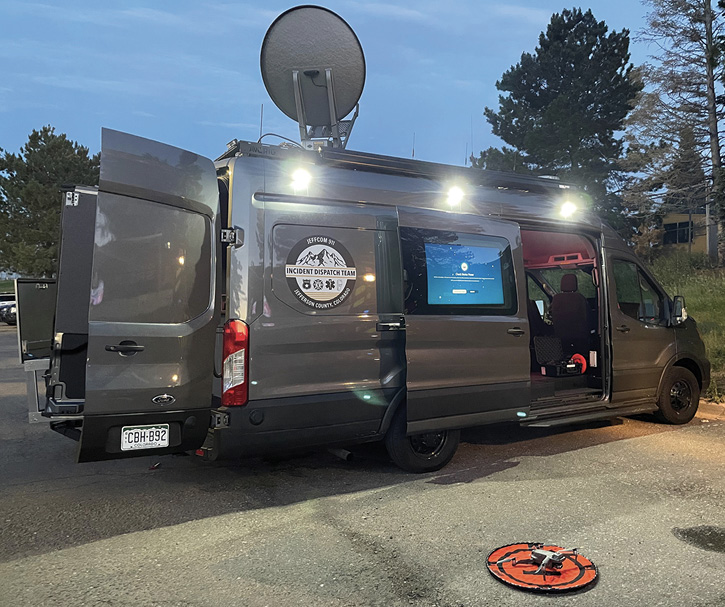
5 The Jefferson County (CO) Communications Center Authority has an Incident Dispatch Team that operates two drones out of a Ford Transit 350. (Photo 5 courtesy of Jefferson County Communications Center Authority.)

6 The Millstone Valley (NJ) Fire Department flies two DJI Matrice 210 drones and two DJI Mavic 2 Enterprise Dual UAVs. (Photo 6 courtesy of Millstone Valley Fire Department.)
Stephen Stashek, deputy chief and UAS program coordinator for the Millstone Valley (NJ) Fire Department, says Millstone Valley flies two DJI Matrice 210 drones outfitted with an XT2 thermal/optical camera and a V30v 30x optical zoom camera and a DJI Mavic 2 Enterprise Dual unit with optical and FLIR cameras, as well as two earlier Mavics used for training. “We can get the Mavic in the air in two minutes or less to give us a quick overview,” Stashek observes.
Stashek says all the department’s drones are carried on its 14-foot enclosed Drone Response trailer. “It has three computer stations with monitors to feed direct video into them, which serves as a command post for the drone team,” he points out. “There’s also another desk, battery chargers, and a generator on the trailer, and it has multi-carrier WiFi, making it a fully independent unit.”
Millstone Valley has flown its drones over structure fires, Stashek notes, using the IR cameras to show hot spots in collapsed areas. “The incident commanders are very grateful for the aerial view,” he says. “A primary function of our drones is search and rescue (SAR) because we have a large number of woods, trails, and hiking and bike paths. We get a number of calls a few times a month for lost or injured people and also do a lot of mutual aid on SAR.”
The Phoenix (AZ) Fire Department has started a program to use drones to find and rescue hikers faster and more efficiently. Last year, the department made 240 mountain rescues, often in extreme heat and over very rough mountain terrain. Phoenix Fire also has plans for a community education program to make the public aware of how the drones will be used, which likely will include fighting structure, brush, and wildland fires as well as making water rescues.
ALAN M. PETRILLO is a Tucson, Arizona-based journalist, the author of three novels and five nonfiction books, and a member of the Fire Apparatus & Emergency Equipment Editorial Advisory Board. He served 22 years with the Verdoy (NY) Fire Department, including in the position of chief.

